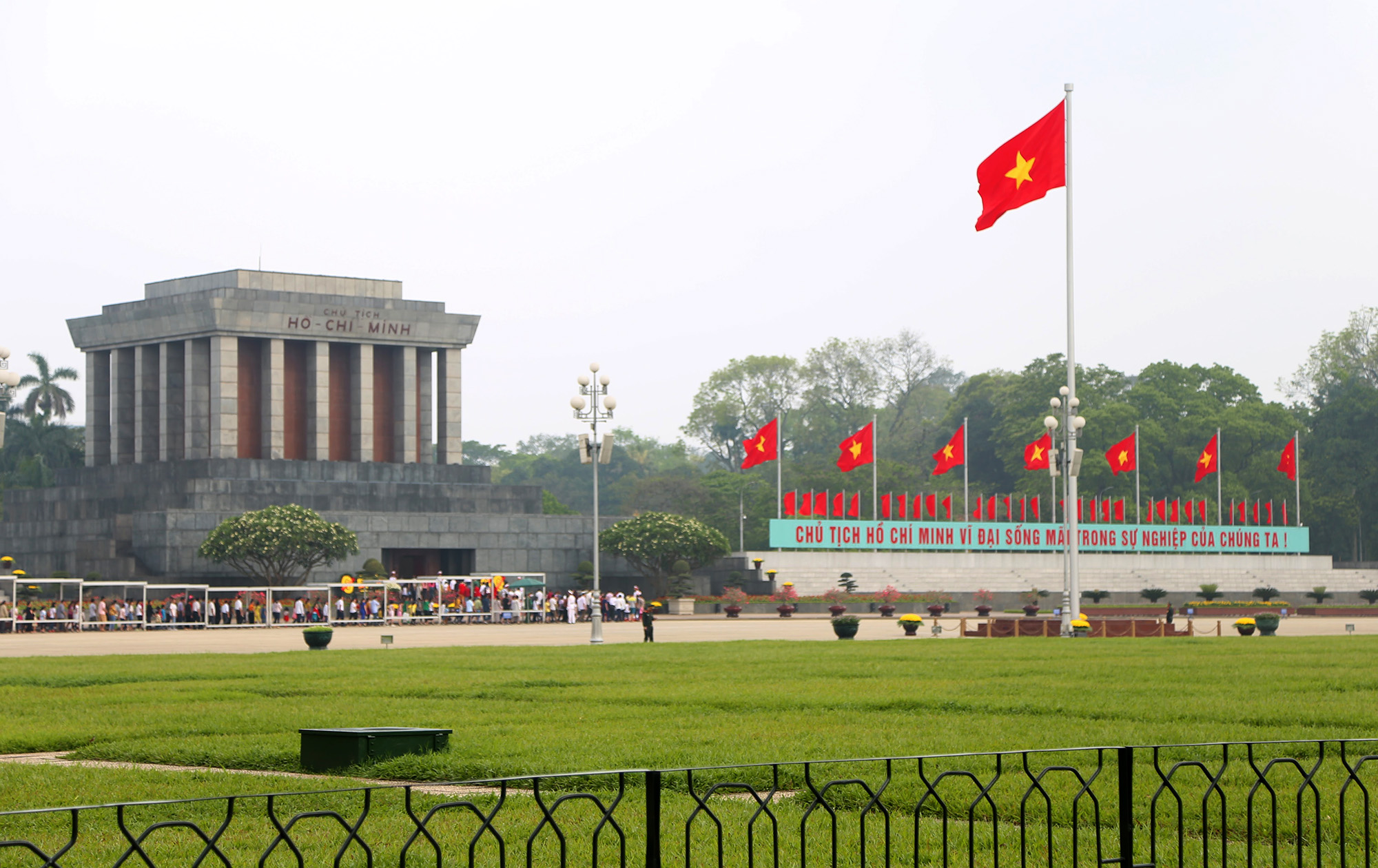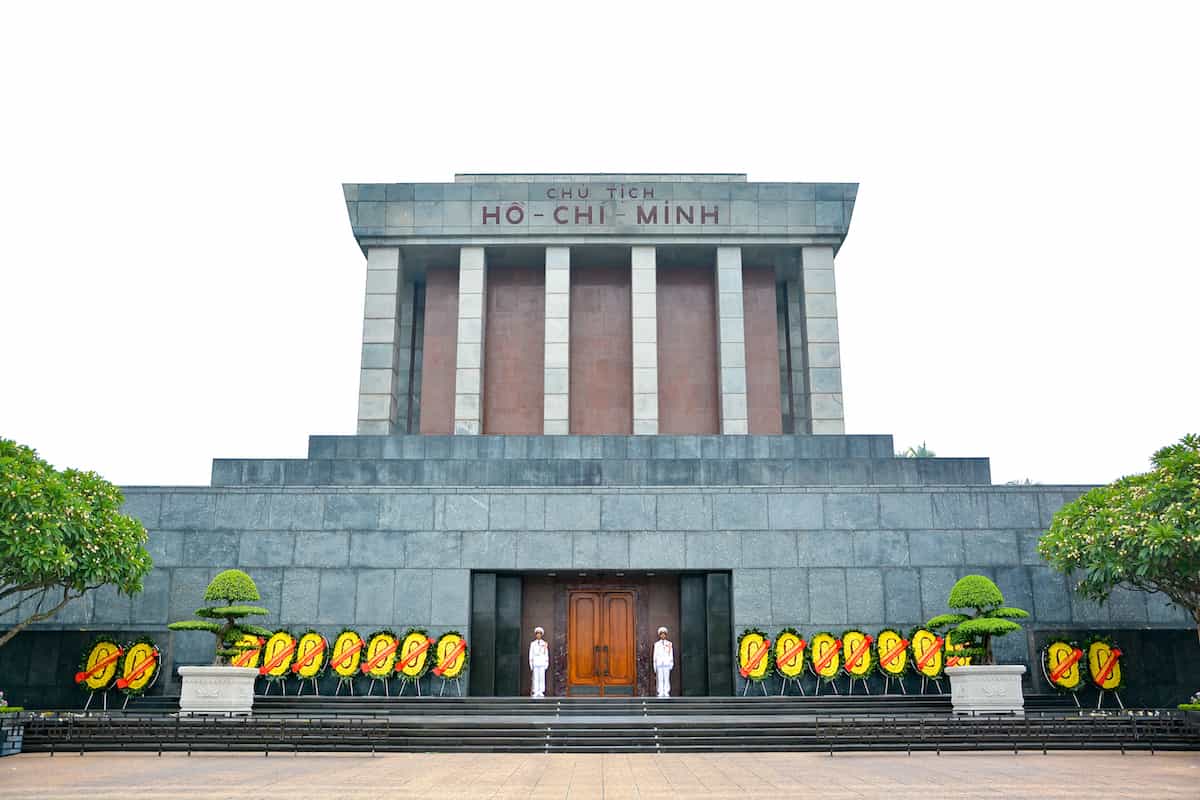Ba Dinh Square, the largest square in Vietnam, is where many important national historical events in modern history took place. This national landmark is a top-listed attraction in every Hanoi tour.
During your Hanoi travel journey, besides enjoying exquisite Vietnamese traditional food, visiting Ba Dinh Square should be one of the top activities on your bucket list. This landmark has been present for all the ups and downs of the nation ever since President Ho Chi Minh proclaimed the Declaration of Independence of Vietnam in 1945. This article will provide you with interesting information about this significant Hanoi historical site
1. About Ba Dinh Square in Hanoi, Vietnam

Ba Dinh Square, situated in front of the well-known Ho Chi Minh Mausoleum, is one of the most popular historical relic sites in Hanoi. It has witnessed many significant events in Vietnamese history.
1.1. Location
Ba Dinh Square is located on Hung Vuong Street, Ba Dinh District, Hanoi. This is also the location of a large complex of historical and cultural sites, known as Ho Chi Minh Mausoleum Complex. The Office of the Central Committee of the Communist Party of Vietnam lies to the north of the square, while the headquarters of the Ministry of Foreign Affairs is to the south, Ho Chi Minh Mausoleum is to the west, and Ba Dinh Hall is to the east.
Ba Dinh Square is 367 meters long and 85 meters wide and can accommodate 200,000 people. It is made up of 210 grass squares connected by wide pathways.
If you want to visit Ba Dinh Square, there are some popular means of transport to choose from, including public buses, motorbikes, taxis, and private cars.
If you have a vehicle, parking is available at the entrance of Ho Chi Minh Museum. If you want to take the bus, you can catch buses number 09, 34, 22. They all make a stop on Le Hong Phong Street, which is only a short walk away from Ba Dinh Square.
1.2. History

- Ba Dinh Square in the feudal age
In 1808, during the reign of King Gia Long, Thang Long Imperial Citadel was renovated into a new smaller citadel. Ba Dinh Square was formerly a western section of this citadel, which was later named “Hanoi” by King Minh Mang.
- Ba Dinh Square in the French colonial period
The area of Ba Dinh Square became vacant land after the French destroyed the citadel when they took control of all of Indochina in 1894. French architects planned this location to be the Indochinese Federation’s administrative hub. On this ground, a flower garden was built, called Le Parc Pugininer.
- Ba Dinh Square in the period of Independence
In 1945, when the Vietnamese took back control of the city, the French names of numerous locations and streets in Hanoi were changed into Vietnamese by Mayor Tran Van Lai. The Le Parc Pugininer garden was renamed Ba Dinh Square, in honor of a resistance army who fought against French colonists in Ba Dinh, Thanh Hoa Province (1886-1887).
After that, the name was changed several times to Independence Square or Hong Bang Garden before President Ho Chi Minh decided to keep the name “Ba Dinh”.
2. Top 5 places to visit in Hanoi, Vietnam near Ba Dinh Square
Ba Dinh Square, located at the center of Ho Chi Minh Mausoleum Complex, is unquestionably a must-see attraction in Hanoi. Coming to the square, you can also visit many nearby historical and cultural landmarks:
2.1. Ho Chi Minh Mausoleum

Ho Chi Minh Mausoleum is a work of great significance, demonstrating the profound affection that Vietnamese people have for President Ho Chi Minh, the renowned revolutionary hero and the founder of the Communist Party of Vietnam. It is situated in front of Ba Dinh Square. The precise address is No. 2, Hung Vuong Street, Dien Bien Ward, Ba Dinh District.
Ho Chi Minh Mausoleum is a solid square building with a height of 21.6 meters and a width of 41.2 meters. The mausoleum’s structure is built to be extremely durable, capable of withstanding floods, bombings, and magnitude-7 earthquakes.
2.2. Ho Chi Minh Museum

Ho Chi Minh Museum is dedicated to the life and career of President Ho Chi Minh. It displays artifacts, photos, dioramas, and pop-art illustrations and paintings to tell the story of Ho Chi Minh’s life at various stages, from the day he was born until the day he passed away.
2.3. Presidential Palace

Presidential Palace is part of the Presidential Palace Historical Site complex, which is where President Ho Chi Minh lived and worked from December 19, 1954 to September 2, 1969. The Presidential Palace was built between 1900 and 1906 as the residence of the Governor-General of French Indochina. Designed in the European style, this was the most luxurious building at the time, having taken approximately 7 years to build.
2.4. Uncle Ho’s stilt house

After the end of the war against the French in 1954, President Ho Chi Minh returned to Hanoi. He refused to live in the opulent Presidential Palace. Instead, he lived and worked in a small house by a pond. The house is mostly supported by wooden stilts. Inside, his items can be seen everywhere. The surrounding area is full of plants, creating an enchanting and peaceful airy space. Visitors can see Uncle Ho’s greatness and simplicity by visiting this place.
2.5. One Pillar Pagoda

One Pillar Pagoda is well-known for its beautiful architecture and historical significance. The pagoda’s structure is said to represent a lotus flower growing out of water. The lotus flower, also known as the flower of dawn, is a symbol of purity, serenity, commitment, and optimism for the future. Locals frequently come here to pray for happiness, success, and good fortune. If you are interested in Buddhist architecture, One Pillar Pagoda is a must-see Hanoi tourist attraction.

